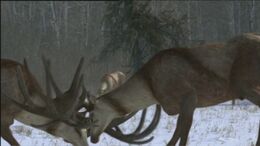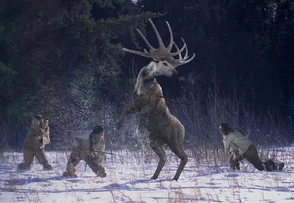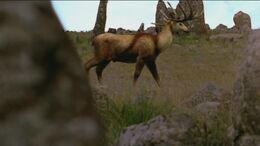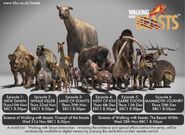Megaloceros giganteus (also commonly known as the "Irish elk") is a species of giant deer (not an elk) which lived during the Pleistocene epoch. It is most closely related to the fallow deer.
Facts

The prehistoric artiodactyls, the Entelodont and Megaloceros on the right.
Megaloceros giganteus is notorious for having the largest set of antlers of any cervid, with the largest known pair being 3.65 (12 ft) meters in total length and weighing up to 40 kg. These antlers were most likely used for rutting and for display during mating season. The animal itself measured up to 2.1 meters (6.9 ft) tall at the shoulder and weighed 540–600 kg with large specimens having weighed 700 kg. Despite its common name and it being found in Irish peat bogs, this animal was not indigenous to Ireland. Megaloceros giganteus' range extended from Eurasia to northern Asia.
It is not the only species of Megaloceros, in fact the genus originally were found in Southern Europe all the way to China. The early species include Megaloceros obscurus, Megaloceros luochuanensis and Megaloceros antecedens, the latter being the ancestor of Megaloceros giganteus. Megaloceros giganteus was the last known species of Megaloceros.
Megaloceros giganteus was not closely related to the modern moose, red deer and wapiti, but to the modern fallow deer. Judging by this, it is possible that Megaloceros fawns had speckles or spots on this body like their modern relatives but this is still under debate.

Male Megaloceros rutting over females. (Mammoth Journey)
Despite being an impressive display, the antlers of Megaloceros giganteus may have presented problems for the animal. The weight of its antlers may have made it difficult for the animal to support its head. The sheer size of its antlers may have disabled it from entering dense forest without getting stuck.
Despite being famous for it's antlers, they are actualy normal for what a deer it's size should have, therefore, it doesn't have "giant antlers" among deer, in a way.
It is perhaps a candidate for de-extinction, but this is uncertain.
Errors
- The colour was slightly off, Megaloceros had darker brown fur. This colour is known thanks to cave art. However this depiction of Megaloceros is the closest to being correct in color as most other depictions show Megaloceros with brown-orange fur, having a hairy dark neck similar to elk and excluding the stripe.
In the series
Walking with Beasts
It appears in the intro of the series leaping at a Cro-Magnon.
Mammoth Journey
A pair of male Megaloceros giganteus were seen rutting over a harem of females. One emerged victorious but his victory was short lived as a team of Cro-Magnon humans began chasing the two males. One male managed to escape but the other was trapped in-between some trees.

Megaloceros attacked by Cro-Magnons.
The Megaloceros was struck by the spears thrown by the humans and slowly died of its injuries.
Walking with Cavemen
The Survivors

A Megaloceros. (The Survivors)
A large male Megaloceros giganteus was seen grazing until a trio of Homo heidelbergensis stalked and attacked it with spears. Whilst the two eldest of the trio were distracting the animal, the youngest went to deliver the final blow. However, the Megaloceros turned to run and hooked the young Homo heidelbergensis over the head with its antlers, causing him to have a concussion. The remaining pair retaliated and killed the animal.

